
ACT Science Practice Test 47
Thời gian làm bài: 1 giờ
Đề thi nằm trong bộ sưu tập: Tuyển Tập Bộ Đề Thi Đại Học Hoa Kỳ (ACT) - Có Đáp Án Chi Tiết
Hãy bắt đầu chinh phục nào!
Xem trước nội dung:
PASSAGE I
Amino acids are considered the building blocks of protein in the body. Amino acids combine with each other to form chains called peptides, which then combine to form proteins. The human body requires twenty different amino acids, whose combinations produce every essential protein in the body. When amino acids form peptides, the residue is what is left after the amino acid sheds a molecule of water (a hydrogen ion from one end and a hydroxide ion from the other end). The reaction rate is the factor by which the protein is able to build itself up through the combination of peptides. Figures 1-3 show the effects that changes in temperature, water volume, and residue concentration have on the rate of reaction when Amino Acids A and B are present. Figure 4 shows the effects that changes in the concentrations of Amino Acids A and B have on the rates of reaction in solutions of the same concentration.
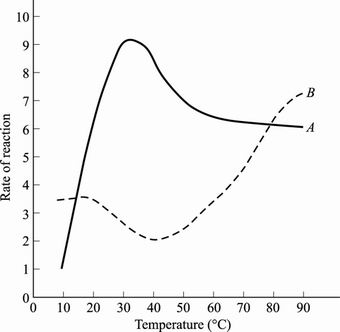
Figure 1
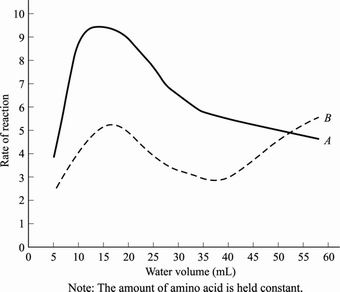
Figure 2
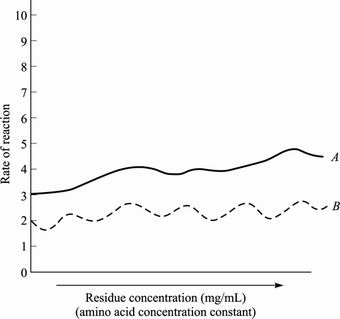
Figure 3
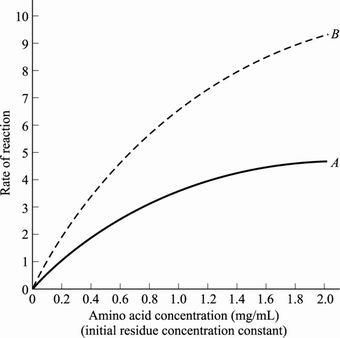
Figure 4
According to Figure 2, Amino Acid A has the highest reaction rate at a water volume closest to:
0 m
4 m
12 m
20 m
Based on the data presented in Figure 2, at approximately which of the following water volumes does Amino Acid A have the same reaction rate as Amino Acid B?
30 mL
40 mL
50 mL
60 mL
A researcher claims that the reaction rate of Amino Acid B is dependent on both residue concentration and amino acid concentration. Do the data in Figures 3 and 4 support this claim?
No, the reaction rate is dependent on the amino acid concentration, but not on the residue concentration.
No, the reaction rate is not dependent on either the residue concentration or the amino acid concentration.
Yes, the reaction rate is dependent on both the residue concentration and the amino acid concentration.
Yes, the reaction rate is dependent on the residue concentration, but not on the amino acid concentration.
A researcher claims that under the conditions used to determine the data for Figure 4, the reaction rate for Amino Acid A at any given concentration will always be greater than the reaction rate for Amino Acid B at the same concentration. Do the data support this conclusion?
No, Amino Acid A has a lower reaction rate at all given residue concentrations tested.
No, Amino Acid A has a lower reaction rate at all given amino acid concentrations tested.
Yes, Amino Acid A has a higher reaction rate at all given residue concentrations tested.
Yes, Amino Acid A has a higher reaction rate at all given amino acid concentrations tested.
The figure below shows the relative reaction rates for alanine, an amino acid found in DNA, and glycine an amino acid found in the muscles.
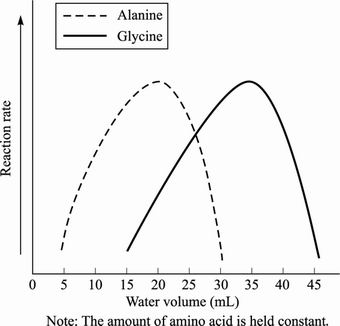
Based on this figure, one would best conclude that compared to the water volume at the peak reaction rate of amino acids in DNA, the water volume at the peak reaction rate of amino acids in the muscles:
is higher.
is lower.
is the same.
cannot be measured.
PASSAGE II
The Great Lakes are a group of five large lakes located in the United States and Canada. They make up the largest group of fresh water lakes in the world, and the Great Lakes-St. Lawrence River system is the largest freshwater system in the world. Recently, near-historic low water levels have plagued the water system. Two scientists discuss the causes of low lake levels in the Great Lakes.
Scientist 1
Water levels are part of the ebb and flow of nature. The determining factor in whether the water level will rise, fall, or remain stable is the difference between the amount of water coming into a lake and the amount going out. When several months of above-average precipitation occur with cooler, cloudy conditions that cause less evaporation, the lake levels gradually rise. Likewise, the lowering of water levels will result from prolonged periods of lower-than-average precipitation and warmer temperatures.
The recent decline of water levels in the Great Lakes, now at lows not seen since the mid-1960s, is due to a number of causes. Higher degrees of evaporation from warmer than usual temperatures in recent years, a series of mild winters, and below-average snow pack in the Lake Superior basin all contribute to the phenomenon. Since precipitation, evaporation, and runoff are the major factors affecting the water supply to the lakes, levels cannot be controlled or accurately predicted for more than a few weeks into the future. Further, the influence of human regulation on lake levels is inconsequential. Because water is added through snow and rain and taken away through evaporation, nature has most of the control over lake levels.
Scientist 2
Several human activities have significantly affected levels and flow of the water in the Great Lakes. For example, structures have been built to regulate the outflows of both Lake Superior and Lake Ontario. Lake Superior has been regulated since 1921 as a result of hydroelectric and navigation developments in the St. Mary's River, such as the Soo Locks. Lake Ontario has been regulated since 1960 after completion of the St. Lawrence Seaway and Power Project. Diversions bring water into, and take water out of, the Great Lakes. Many such diversions were constructed for hydropower generation and logging. For example, the Lake Michigan diversion at Chicago moves water out of Lake Michigan and into the Mississippi River for domestic, navigation, hydroelectric, and sanitation purposes.
In addition, the St. Clair and Detroit rivers have been dredged and modified. This has caused some drop in the levels of Lake Michigan and Lake Huron. Channel and shoreline modifications in connecting the channels of the Great Lakes have affected lake levels and flows as well, because the infilling of shoreline areas can reduce the flow carrying-capacity of the river. Further, the extensive use of groundwater deposited in massive aquifers (underground layers of water-bearing permeable rock) in the Midwest has affected the lake levels. Vast quantities of water deposited in aquifers surrounding the Great Lakes are taken to population centers outside of the Great Lakes' watershed (region of land whose water drains into a specified body of water). Thus, the water in the lakes is not replenished.
Which of the following best describes the major point of difference between the scientists' viewpoints?
The major contributing factor of low lake levels.
The effects of water use on the environment.
The effects of reduced lake levels.
The major function of the Great Lakes.
With which of the following statements would both scientists likely agree?
The probability of lake level fluctuation is small.
Human activity is largely responsible for the changes in lake levels.
Recent trends show that the lake levels are decreasing.
The decreased lake levels are not a major concern.
Which of the following statements best describes how Scientist 1 would explain why human interference is of little importance in determining lake levels?
Aquifer use has little effect on lake levels.
Rivers flowing into the Great Lakes raise the water levels in the lakes.
Dredging or widening rivers can cause reductions in water levels in the lakes.
Lake levels are mainly controlled by nature and not manipulated by humans.
According to Scientist 2, human activity diverts lake waters, thus:
decreasing the density of the water in the lakes.
reducing the amount of water in the lakes.
increasing the amount of water in the lakes.
changing the weather patterns.
Scientist 1's viewpoint would most likely be weakened by which of the following statements?
Lake level fluctuation has severe consequences for coastal communities.
Studies have shown precipitation and evaporation levels to be stable for the last 50 years.
Studies detailing aquifer use announce a dramatic increase in volume in the last 5 years.
Recreational boating releases thousands of gallons of petroleum-based chemicals into the water system each year.
Scientist 2 claims that all of the following are human activities that are decreasing lake levels EXCEPT:
destruction of watershed tributaries.
diversions for domestic, navigation, hydroelectric, and sanitation purposes.
dredging and modification of rivers.
infilling of shoreline areas.
How would the effect of the use of aquifer water differ from that described by Scientist 2 if all of the water taken from aquifers that surrounds the Great Lakes was used within the Great Lakes' watershed? The use of aquifer water would:
continue to cause decreases in lake levels.
affect lake levels to a lesser degree.
have an increased effect on receding lake levels.
increase levels of pollution within the watershed region.
Xem thêm đề thi tương tự

12 câu hỏi 1 mã đề 1 giờ
214,143 lượt xem 115,283 lượt làm bài

24 câu hỏi 1 mã đề 1 giờ
219,455 lượt xem 118,132 lượt làm bài

26 câu hỏi 1 mã đề 1 giờ
219,214 lượt xem 118,020 lượt làm bài

22 câu hỏi 1 mã đề 1 giờ
219,728 lượt xem 118,293 lượt làm bài

12 câu hỏi 1 mã đề 1 giờ
218,864 lượt xem 117,831 lượt làm bài

24 câu hỏi 1 mã đề 1 giờ
219,350 lượt xem 118,090 lượt làm bài

24 câu hỏi 1 mã đề 1 giờ
218,456 lượt xem 117,614 lượt làm bài

22 câu hỏi 1 mã đề 1 giờ
208,288 lượt xem 112,133 lượt làm bài

29 câu hỏi 1 mã đề 1 giờ
215,754 lượt xem 116,158 lượt làm bài
